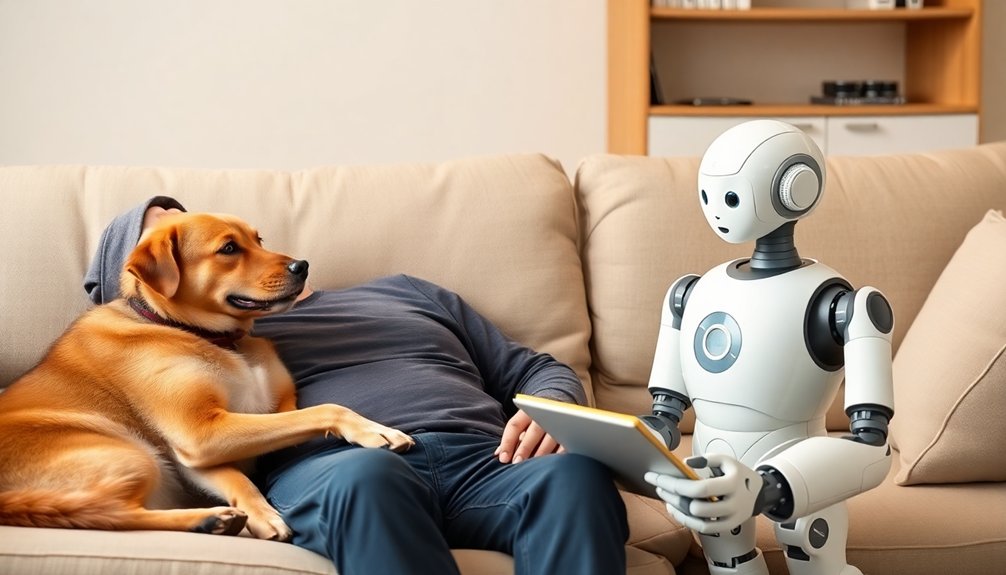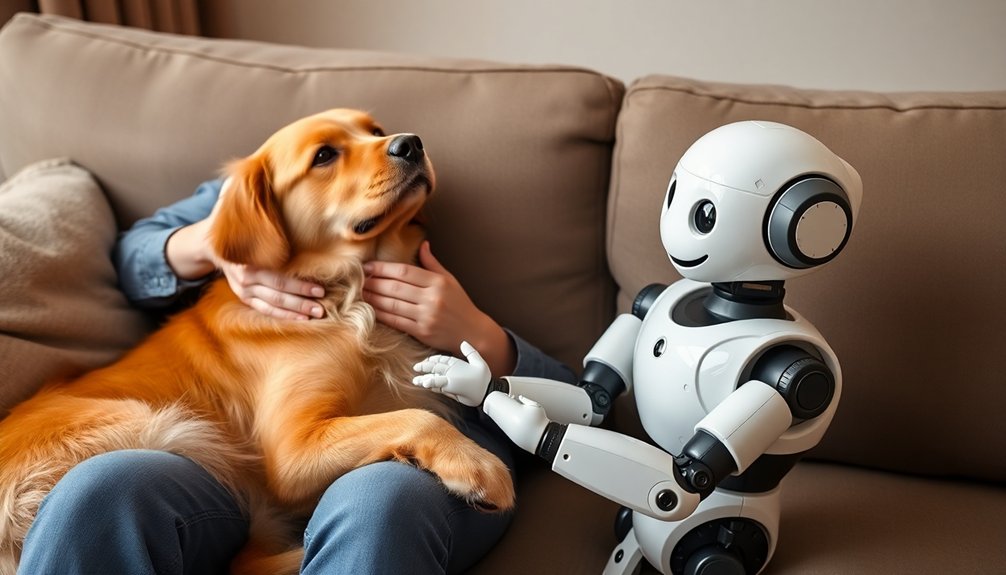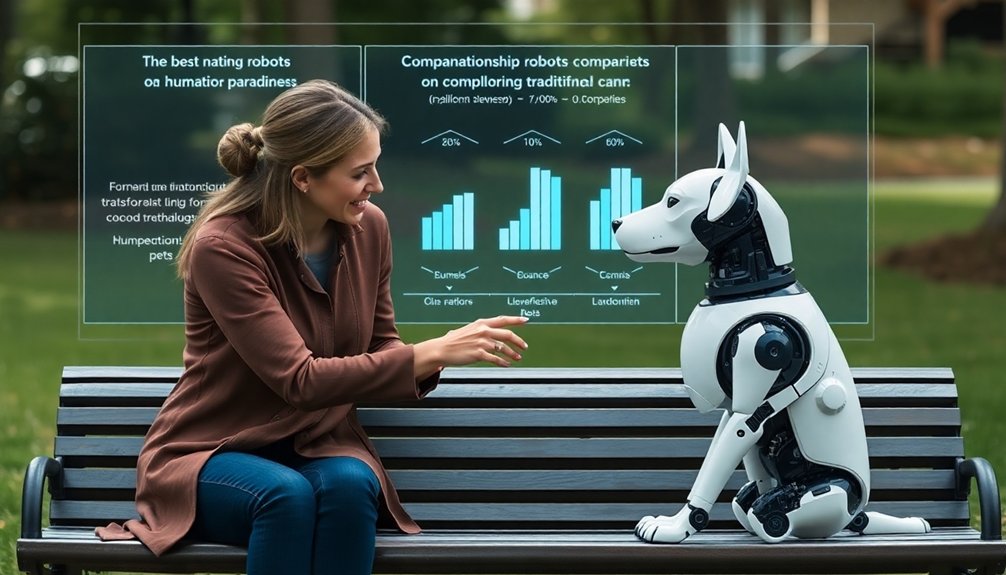Table of Contents
Dogs win hands down. They’re living, breathing emotion machines that robots can’t touch. Sure, tech is cool, but can a robot wag its tail when you walk in? Nope. While humanoid companions might look impressive, they lack soul. Dogs read our moods, comfort us instinctively, and offer unconditional love. Robots simulate connection; dogs create it. Want to know how deep this companionship rabbit hole goes? Stick around.
The Heart of Companionship: Emotional Bonding Explored

When it comes to emotional bonding, humans are surprisingly adaptable creatures—willing to form connections with everything from slobbering canines to sleek, programmed machines.
We’ve discovered that our hearts don’t discriminate between furry companions and metallic buddies. Dogs naturally nail emotional reciprocity, wagging tails and reading our moods like emotional translators. Robotic emotional attachment research suggests humans can develop surprisingly deep connections with technological companions. Neuromorphic computing enables robots to process emotional nuances beyond simple binary responses.
Robots, however, play a trickier game—they simulate connection without genuinely understanding it. Think of them as sophisticated mirrors reflecting what we want to see. Research indicates that humans can develop neural empathy response toward robots, with brain activity showing similar patterns of emotional engagement as with human interactions.
Sure, they can reduce stress and provide situational support, but can they genuinely validate our deepest feelings? Not really. The robot’s emotional toolkit is more algorithm than empathy, while a dog’s connection runs deeper than code.
Our emotional landscape is complex, and right now, biological beats artificial—hands down.
Care and Comfort: Practical Considerations of Pets
Because pet ownership isn’t all cuddles and Instagram-worthy moments, let’s plunge into the gritty reality of keeping a furry (or robotic) companion. Companion robots could potentially offer an alternative to traditional pet care challenges.
We’re talking cold, hard costs—routine vet visits averaging $138, insurance coverage for just 4.4 million pets, and time-consuming care requirements. Parasite control is another significant expense, with studies showing up to 28.1% of cats and 14.4% of dogs carrying fleas or other parasitic infections.
Dogs demand more attention: regular exercise, training, and outdoor access. They’ll wreck your furniture, need space, and require consistent veterinary check-ups.
Cats might be lower maintenance, but they’re not worry-free. We’re looking at nutritional needs, potential home modifications, and legal responsibilities that can make pet ownership feel like a part-time job.
Oral health issues are a critical concern, with 85% of adult dogs and 80% of adult cats showing signs of dental disease that can lead to serious chronic health problems.
The real question is: Are we ready for this commitment? A humanoid robot might start looking pretty appealing when you’re cleaning up another “accident” or scheduling yet another vaccination appointment.
Healing Companions: Therapeutic and Mental Health Benefits

Robots and dogs aren’t just cute sidekicks—they’re potential mental health lifelines. Imagine a world where a programmed robot or a tail-wagging friend can reduce your anxiety, spark social connections, and offer genuine comfort. Social robots like Pepper and NAO are specifically designed to enhance children’s emotional skills and provide structured therapeutic support. Educational robotics are projected to reach $5.1 billion by 2032, indicating a growing potential for technological emotional support. Studies have shown that socially assistive robots can significantly reduce stress and anxiety in controlled environments, particularly among elderly populations.
Humanoid robots bring structured emotional support, while dogs deliver raw, instinctive companionship. They’re like two different therapists: one clinical and precise, the other wonderfully unpredictable.
Both can help people battling loneliness, stress, and social challenges. Whether it’s a robot teaching social skills to a neurodivergent child or a dog reducing an elderly person’s isolation, these companions are more than just tools—they’re bridges to emotional wellness.
The future of mental health? It’s looking furry and metallic.
Innovation in Interaction: Technological Advancements
As robots evolve from clunky sci-fi fantasies into sleek, intelligent companions, we’re witnessing a technological revolution that’s blurring the lines between machine and living creature. Reinforcement learning technologies enable these robots to learn through continuous trial and error, receiving rewards or penalties that help them adjust their behavior in real-time. Humanoid robot challenges like mobility and complex programming are gradually being overcome through persistent technological advancements. Neural network adaptations allow these robotic systems to process complex sensory information with unprecedented sophistication.
Humanoid robots and robot dogs aren’t just fancy toys anymore—they’re learning, adapting, and potentially replacing human roles in complex environments. Companies are racing to create machines that can walk, think, and problem-solve like us, but with superhuman precision.
Imagine a robot dog traversing a disaster zone or a humanoid assistant performing delicate medical procedures. These aren’t wild dreams; they’re emerging realities powered by AI and advanced robotics.
We’re watching technology transform from rigid, programmed tools into dynamic, almost-alive systems that can learn, respond, and potentially outsmart their human creators.
Touch and Connection: Physical Interaction Dynamics

Technological wizardry might make robots look increasingly human, but touch reveals the canyon between machine and living companion. Neurological research in pet interactions suggests that our brain’s emotional processing centers respond dramatically differently to living versus artificial beings. Dogs offer warmth, spontaneity, and genuine connection—robots provide programmed simulations. Our research reveals stark differences in tactile interactions:
| Interaction Type | Emotional Impact | Authenticity |
|---|---|---|
| Real Dog Touch | High | Genuine |
| Robot Touch | Low | Mechanical |
| Humanoid Robot | Minimal | Simulated |
Consider how a dog’s tail wag or nudge communicates volumes, while a robot’s touch feels calculated and cold. Oxytocin levels spike with animal contact but plateau with machines. Advanced AI companions struggle to replicate the intricate emotional nuances that make physical interactions meaningful. We’re wired for living, breathing connections—not algorithmic approximations of companionship. Robots might mimic movement, but they can’t replicate the unpredictable, nuanced dance of real relationship. Touch isn’t just physical; it’s emotional language robots haven’t learned to speak. Interaction study findings demonstrated that participants consistently rated live animals as more capable and engaging than robotic entities.
Sensory Experience: Understanding Emotional Responses
When we explore touch and emotional responses between humans, dogs, and robots, it’s like comparing a Swiss Army knife to a precision surgical tool.
Our sensory experiences reveal that dogs’ warm, unpredictable reactions trigger deeper emotional connections than the calculated, repetitive gestures of humanoid robots.
Imagine trying to feel genuine comfort from a machine that responds with programmed empathy—it’s like getting a hug from a vending machine.
Touch Sensation Impact
Imagine touch as a universal language that bridges the gap between cold machinery and warm-blooded companions.
We’ve discovered that touch isn’t just skin-deep—it’s a complex communication tool. Robots are learning to “feel” through advanced tactile sensors, while dogs have millennia of emotional touch expertise.
Both can build trust through gentle contact: a robot’s programmed caress or a dog’s comforting nudge.
But here’s the twist—dogs do it naturally, robots do it through complex algorithms.
We’re witnessing a fascinating dance of technology and instinct, where machines try to mimic what comes effortlessly to our four-legged friends.
Can robots genuinely replicate the emotional depth of a canine’s touch? The jury’s still out, but the race is getting interesting.
Emotional Response Depth
Because emotional depth isn’t a switch you can simply flip, understanding how robots and dogs process feelings becomes a fascinating psychological puzzle. Our exploration reveals stark differences in emotional resonance.
| Dogs | Robots |
|---|---|
| Natural Emotions | Programmed Responses |
| Intuitive Connection | Calculated Interaction |
| Sensory Rich | Sensory Limited |
| Evolving Bonds | Static Engagement |
Robots might recognize emotions, but they can’t genuinely feel them. Dogs communicate through nuanced body language, scent, and vocal cues that tap directly into human empathy. While AIBOs attempt emotional mimicry, they’re fundamentally elaborate machines playing emotional charades. Dogs, in contrast, offer authentic emotional experiences that evolve naturally. They’re not just responding—they’re connecting. Sure, technology advances, but can an algorithm really replace the tail-wagging, soul-connecting power of a living, breathing companion? Not likely.
Sensory Connection Dynamics
How do living, breathing creatures connect with their environment in ways cold machines can never authentically replicate?
Dogs navigate sensory landscapes with an intuitive grace that makes robots look like clumsy algorithms. They don’t just process signals—they feel them. Our four-legged friends read emotional currents through a complex symphony of scent, sound, and subtle body language.
A robot might detect a frown, but it can’t sense the underlying heartache. While technology advances, there’s something profoundly intimate about a dog’s ability to tune into human energy—a biological radar honed through millennia of companionship.
Machine learning can mimic, but it can’t genuinely understand the nuanced dance of emotional connection that comes naturally to dogs. They’re not just sensing; they’re connecting.
Lifestyle and Adaptability: Companion Suitability
When it comes to companionship, dogs and robot dogs aren’t created equal—and that’s putting it mildly.
We’ve discovered some fascinating nuances in companion suitability:
- Real dogs demand significant time and energy, requiring walks, training, and emotional investment.
- Robot dogs slide seamlessly into urban lifestyles, perfect for apartment dwellers with zero pet-care bandwidth.
- Biological dogs offer unpredictable joy and spontaneous interactions, while robotic companions deliver consistent, programmed experiences.
- Living situations dramatically influence companion choice—allergies, space constraints, and lifestyle rhythms determine whether a furry friend or mechanical marvel makes more sense.
Ultimately, companion selection isn’t just about convenience—it’s about connection.
Robot dogs might fill a functional gap, but they can’t replicate the messy, magnificent magic of a real dog’s unconditional love. At least, not yet.
Future of Companionship: Evolving Relationship Paradigms

While our grandparents might’ve laughed at the idea of falling in love with a robot, we’re standing at the precipice of a wild new relationship frontier.
Technology’s rewriting the companionship rulebook, and suddenly our potential partners aren’t just human — or even alive. AI companions are becoming emotional Swiss Army knives: customizable, consistent, and weirdly intuitive.
Want unconditional support without dog hair? There’s an algorithm for that.
Craving emotional backup minus the messy maintenance? AI’s got your perfectly programmed support system.
We’re witnessing a social revolution where emotional connections transcend biological boundaries. Young generations are more likely to swipe right on a personalized digital companion than commit to traditional relationships.
The crazy part? These robotic buddies might actually understand us better than most humans. They’re learning, adapting, and — dare we say — feeling.
Our relationship landscape is mutating, and we’re here for this beautifully bizarre ride.
People Also Ask
Can Robotic Pets Truly Replace the Emotional Bond of a Real Dog?
We can’t fully replace the deep emotional connection dogs provide. While robotic pets offer innovative companionship, they lack the unconditional love, loyalty, and profound oxytocin-driven bonding that real dogs naturally create with humans.
Are Robotic Companions Safe for Children and Elderly Individuals?
We’re traversing uncharted technological waters where robotic companions dance between promise and peril. Safety concerns loom large, with potential risks to vulnerable populations, demanding rigorous standards, thorough testing, and careful, thoughtful implementation before widespread adoption.
How Expensive Are Advanced Robotic Pets Compared to Adopting a Dog?
We’ve found advanced robotic pets can cost considerably more upfront than dog adoption. While a dog might set you back $50-$600, high-end robotic companions like Loona or Unitree Go2 range from $499 to $1,600.
Do Robotic Pets Require Specialized Training or Technical Knowledge?
We’ve found that robotic pets do require technical skills. You’ll need to understand device setup, software interfaces, and troubleshooting. While not as complex as training a live dog, they demand specific technological knowledge for effective interaction.
Can People With Severe Animal Allergies Benefit From Robotic Companions?
Like a refreshing change for allergy sufferers, we’ve found robotic companions offer a sneeze-free solution. They provide companionship without triggering allergic reactions, delivering predictable interactions and comfort in environments where real pets pose health risks.
The Bottom Line
As tech and companionship evolve, we’re witnessing a wild frontier. Did you know 68% of people already feel emotionally connected to AI devices? We’re not replacing dogs, but expanding our definition of connection. Humanoid robots offer precision; dogs offer soul. The future isn’t about choosing sides, but understanding how technology and organic relationships can coexist and complement each other. Our companions are becoming more complex, and so are we.
References
- https://pubmed.ncbi.nlm.nih.gov/40460066/
- https://allwork.space/2024/08/real-vs-robotic-pets-which-makes-the-better-coworking-companion/
- https://virtual-paws.com/why-do-people-buy-robot-dogs/
- https://journals.plos.org/plosone/article/file?type=printable&id=10.1371/journal.pone.0324312
- https://www.youtube.com/watch?v=lcRhpZNpml4
- https://www.tandfonline.com/doi/full/10.1080/10447318.2024.2445100
- https://robotics.umich.edu/news/2019/humans-and-robots-the-emotional-connection/
- https://dl.acm.org/doi/fullHtml/10.1145/3526105
- https://www.frontiersin.org/journals/psychology/articles/10.3389/fpsyg.2024.1347177/full
- https://emildai.eu/love-loss-and-ai-emotional-attachment-to-machines/